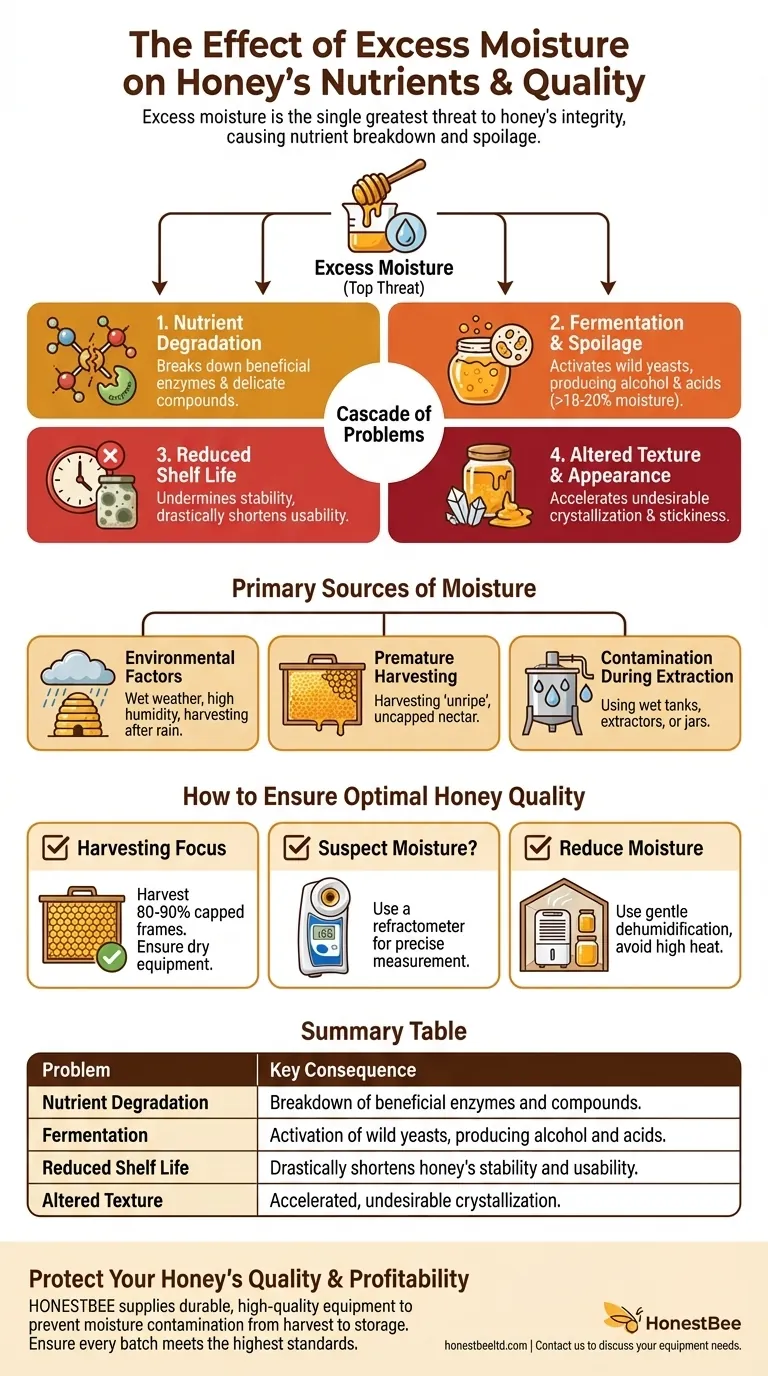In short, excess moisture is the single greatest threat to the nutritional integrity and stability of honey. It actively promotes the breakdown of essential nutrients and enzymes, creates an environment ripe for fermentation by wild yeasts, and ultimately reduces the overall quality and health benefits of the final product.
The core issue with high moisture is not mere dilution. It fundamentally changes honey from a stable, preserved food into an active environment where microorganisms can thrive, leading to fermentation and the degradation of its most valuable components.

The Cascade of Problems Caused by Excess Moisture
Understanding why moisture is so detrimental requires looking at the chain reaction it triggers within the honey. Each problem exacerbates the next, leading to a rapid decline in quality.
Nutrient Degradation
Excess water acts as a catalyst for chemical reactions that break down the beneficial compounds in honey. This includes delicate enzymes and other nutrients that contribute to its health properties.
Fermentation and Spoilage
Honey naturally contains dormant osmophilic yeasts. When the moisture content rises above a certain threshold (typically around 18-20%), these yeasts activate and begin to ferment the sugars, producing alcohol and acids. This process is similar to making mead, but in this context, it is considered spoilage.
Reduced Shelf Life
Properly cured, low-moisture honey is famously stable and can last for years. Fermentation completely undermines this stability, drastically reducing the honey's shelf life and making it unsuitable for consumption.
Altered Texture and Appearance
Excess moisture can also disrupt the delicate balance of sugars in honey. This can lead to accelerated crystallization, which affects the texture, and can make the honey sticky and difficult to handle or dispense from its packaging.
Understanding the Primary Sources of Moisture
Preventing moisture contamination is far more effective than trying to correct it later. The problem almost always originates from one of three areas.
Environmental Factors
Harvesting during a wet spring or in a consistently humid climate can result in nectar that has a naturally higher water content. Likewise, harvesting honey shortly after a rainstorm can introduce excess moisture.
Premature Harvesting
Bees are masters of dehydration. They cure nectar until it reaches the optimal moisture content before capping the honeycomb cell with wax. Harvesting honey from uncapped or partially capped frames is a primary cause of high-moisture, "unripe" honey.
Contamination During Extraction
Even perfectly cured honey can be ruined during processing. Using extraction equipment, tanks, or jars that are not completely dry will introduce water directly into the batch, initiating the degradation process.
How to Ensure Optimal Honey Quality
Your approach should be tailored to your specific role, whether you are harvesting honey or simply storing it. The goal is always to maintain a low moisture content.
- If your primary focus is harvesting for maximum quality: Harvest only frames that are at least 80-90% capped, avoid harvesting immediately after rain, and ensure all your extraction equipment is meticulously dry.
- If you suspect your honey has high moisture: Use a honey refractometer to get a precise measurement. This data is critical before deciding on any corrective action.
- If you must reduce moisture in a finished batch: Use gentle methods like placing the honey in a sealed room with a dehumidifier. Avoid high heat, as excessive temperatures can destroy the very enzymes and delicate flavors you are trying to preserve.
Ultimately, preventing moisture contamination from the start is the most effective strategy for preserving the integrity and benefits of your honey.
Summary Table:
| Problem | Key Consequence |
|---|---|
| Nutrient Degradation | Breakdown of beneficial enzymes and compounds. |
| Fermentation | Activation of wild yeasts, producing alcohol and acids. |
| Reduced Shelf Life | Drastically shortens honey's stability and usability. |
| Altered Texture | Accelerated, undesirable crystallization. |
Protect Your Honey's Quality and Profitability
Excess moisture is a primary cause of spoilage and financial loss for commercial apiaries. HONESTBEE supplies the durable, high-quality beekeeping equipment and extraction supplies that help you prevent moisture contamination from harvest to storage. Our wholesale-focused operations are designed to meet the demands of commercial beekeepers and distributors.
Ensure every batch meets the highest quality standards. Contact HONESTBEE today to discuss your equipment needs and protect your product's integrity.
Visual Guide

Related Products
- Precision Honey Refractometer Instrument for Quality Assessment
- Professional Thermostatic Conical Honey Melter
- Honey Concentrating Vacuum Heating Thickening Machine Dehumidifier for Honey
- 0.5T Capacity Honey Dehumidifier Dryer with Vacuum Heating and Thickening Filtering Machine
- HONESTBEE 3-Frame Manual Acrylic Honey Extractor
People Also Ask
- What is a honey refractometer? The Essential Tool for Perfect Honey Quality
- What are the key steps to using a honey refractometer? Ensure Honey Quality & Prevent Fermentation
- What is a honey refractometer and what is its purpose? Ensure Honey Quality and Prevent Spoilage
- What are the features of the Standard Refractometer for honey moisture content? Essential Tools for Quality Control
- Why is a honey refractometer considered essential for commercial beekeepers? Ensure Honey Quality and Profitability



















